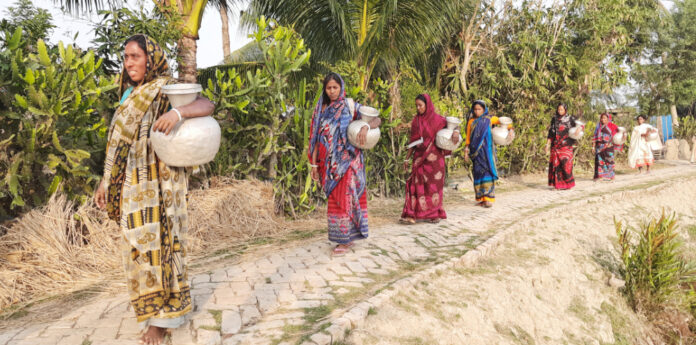DHAKA: Growing up, it only took Hosnera Begum a quick stroll to the ponds near her home to fetch fresh water.
These days, the 27-year-old must walk more than 2 km every day to gather 20 liters of safe drinking water for her family, as encroaching seawater increasingly contaminates supplies in her home village in Gabura, in southern Bangladesh.
“In my childhood the problem was not so severe,” Begum told Arab News. “Now the situation is getting worse every day. There are only a couple of ponds protected from getting mixed with salt water … providing drinking water to thousands of us.”
Gabura, located in the Ganges Delta and under Satkhira district, is home to around 45,000 people.
Begum is among millions living in coastal Bangladesh who have suffered through the devastating impacts of climate change. Increased cyclones, higher tides, and flooding have particularly brought salt water further inland, contaminating precious sources of drinking water.
Bangladesh, a country of about 167 million people, is among the hardest-hit by climate change, despite contributing only a fraction of the world’s emission. The Intergovernmental Panel on Climate Change estimates that a 45 cm sea-level rise will inundate almost 11 percent of the country’s territory and displace 5.5 million people from the coastal regions.
Mohon Kumar Mondal, head of LEDARS Bangladesh, a local organization working on climate resilience, said the impacts of climate change have affected Gabura residents for more than two decades.
Though residents can still get fresh water from the local ponds, the filtration process does not generate pure drinking water and subsequently affects people’s health.
“(It results) in a high number of water-borne diseases, skin diseases, and cervical cancer among the people,” Mondal told Arab News.
Another Gabura resident, 45-year-old Shahida Begum, said increasing salinity of the soil in coastal villages has also impacted rice farming, the region’s traditional occupation.
“We can’t grow rice anymore on our paddyfields,” she told Arab News. “Earlier, we could grow different freshwater fish in the ponds. But now the ponds are without any fish.”
Salinity in soil, according to a 2010 study by Bangladesh’s Soil Resources Development Institute, has increased by 26 percent over the past 35 years.
Shahida said other villagers have switched to shrimp cultivation, which does not need many day laborers, using land previously used to grow rice.
Climate scientist Prof. Atiq Rahman said coastal regions must focus on adapting against the impacts of climate change “since there is no way to undo the situation.”
Rahman told Arab News: “People have come up with innovative solutions in terms of agriculture and cattle rearing, these kinds of innovations should be promoted and the knowledge disseminated among people across the coastal regions.”
The local government in Gabura said harvesting rainwater is the only sustainable solution for the islanders.
“But government initiatives are not enough, in contrast to huge demand for rainwater harvesting plants,” Masudul Alam, chairman of local government representative body Gabura Union, told Arab News.
Alam said the government managed to distribute rainwater harvesting plants for six families in the last year, out of 7,000 affected households in the region.
For people living in places severely impacted like Gabura, climate change has forced them to leave. Data from the Bangladesh Bureau of Statistics show that the population rate in the area has declined, with thousands of men migrating elsewhere in the country over the years.
But that is not feasible for some like Begum, who earns a meager $2.50 daily.
“Since I can’t afford a town life, I have to continue living here with the most hardships caused by nature,” she said.

